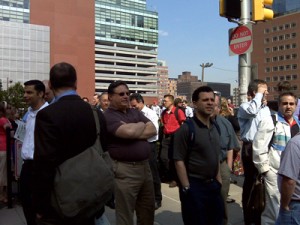The Alliance for Downtown New York hosted the Small Business Community Expo, a networking event for small business owners, advocates and service providers. Alliance president Liz Berger stated that “people are really pushed and empowered by the current economy to try things they haven’t tried before. They’re hungry for knowledge and they want to know that they’re not out there by themselves.” It often feels that way. Wall Street has lost nearly 20,000 jobs since August 2008, according to the New York State Department of Labor. And Wall Street isn’t the only Manhattan industry that is downsizing; the media and fashion industries are also in trouble. But in Lower Manhattan, where rebuilding the World Trade Center site is moving at a glacial pace, it is small consolation to know that it isn’t just the financial district that is experiencing the economic pain. However, the Alliance for Downtown New York points out that that despite Lower Manhattan’s reputation as an extension of Wall Street, less than a third of jobs in the area are finance-related, and a growing number of them are in the creative and nonprofit industries. In addition, they say, the residential population of Lower Manhattan grew 11% last year, to 53,900, and is forecast to reach 60,000 by 2011. The growth of the residential population in an area that used to go dark at 7:00 p.m. as financial district workers left for home creates an opportunity for small businesses to provide retail services that the residents will demand, so says the Alliance.
I am all for an optimistic outlook on life, so I applaud the brave efforts of the Alliance to try to do something for economic development by reaching out to small businesses. But there is no way that this development can be interpreted as anything by the sad consequence of disastrous government policies. Lower Manhattan has become a miserable place to live, I know. The round-the-clock and unpredictable disruptions around rebuilding the World Trade Center site, orchestrated for nearly one decade by those who don’t have to live in the area, has taken its toll on the community. The encouragement to offer new retail services to new residents is a bit misleading; while the residential population has increased, it has not done so at a rate sufficient to offset the decline in employees in the area, employees who sustained restaurant and other retail businesses. I have watched as neighborhood fixtures like Foxhounds go out of business because the loss of 20,000 jobs in Wall Street following the loss of 50,000 workers based at the World Trade Center basically wiped out their luncheon business and the new residents are not dining out enough to offset that loss.
And you wonder how long the new residents will stick around. Many of the residential apartments were conversions motivated not by market demand but by incentives, such as Liberty Bonds, offered to real estate developers. One such result is the conversion of 180 Maiden Lane, which used to be the office of Cadwalader, Wickersham & Taft, a Wall Street law firm. I toured the apartments with a broker; they had all the charm of a law clerk’s cubicle. You could almost imagine Bartleby the Scrivener hunched over his desk here. The real estate developers apparently were unwilling to spend the money required to do a complete gut renovation and change the bones of the building to make the place feel like home. Still, the interior is less depressing than stepping outside and looking at all of the half-finished construction projects, stalled for lack of financing. These projects were not motivated by market demand; they were a response to corporate welfare offered by post-9/11 reconstruction plans of the government. Small wonder that many of the journalists who work for the Wall Street Journal are looking forward to leaving the World Financial Center and moving to 1211 Avenue of the Americas in mid-town Manhattan. My friends who continue to work in the neighborhood describe it as a “ghost town”.
What is so sad is that the events of 9/11 notwithstanding, Lower Manhattan was a vibrant community of economically productive small businesses. When government policy decided to distort market mechanisms for supply and demand, we were displaced to make way for boondoggle real estate projects that were dependent of subsidies and ultimately, were not sustainable. Many of the new residents of Lower Manhattan chose to live there, despite the poor quality of life, for its proximity to work and the incentives offered to sign apartment leases. Basically, you had to bribe people to live there. But when Merrill Lynch, AIG and others got into trouble, residents lost their employment and until they find new work, they cannot afford to move. But rest assured that once they find new jobs, they will. Even if a few new restaurants and shops appear to serve this transient residential population, these are low-margin businesses that don’t generate the kinds of returns to replace the employment and tax base supported by the commercial businesses that were driven out. If you doubt me, go to the Tiffany’s shop on Wall Street at lunch hour and observe that there is not a single customer there. The market would have adjusted supply and demand for commercial real estate in the aftermath of 9/11 by the mechanism of price. Offering corporate welfare to wealthy real estate developers allowed them to continue to benefit from a real estate bubble that should have burst a bit earlier. But the distortions effectively destroyed a community. Only now are politicians and various business improvement district groups recognizing the importance of local small businesses – now that we are gone.





